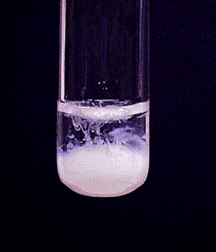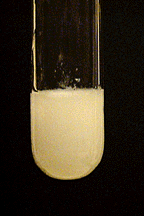Characteristic Reactions of Calcium Ions (Ca²⁺)
- Page ID
- 97266
\( \newcommand{\vecs}[1]{\overset { \scriptstyle \rightharpoonup} {\mathbf{#1}} } \)
\( \newcommand{\vecd}[1]{\overset{-\!-\!\rightharpoonup}{\vphantom{a}\smash {#1}}} \)
\( \newcommand{\id}{\mathrm{id}}\) \( \newcommand{\Span}{\mathrm{span}}\)
( \newcommand{\kernel}{\mathrm{null}\,}\) \( \newcommand{\range}{\mathrm{range}\,}\)
\( \newcommand{\RealPart}{\mathrm{Re}}\) \( \newcommand{\ImaginaryPart}{\mathrm{Im}}\)
\( \newcommand{\Argument}{\mathrm{Arg}}\) \( \newcommand{\norm}[1]{\| #1 \|}\)
\( \newcommand{\inner}[2]{\langle #1, #2 \rangle}\)
\( \newcommand{\Span}{\mathrm{span}}\)
\( \newcommand{\id}{\mathrm{id}}\)
\( \newcommand{\Span}{\mathrm{span}}\)
\( \newcommand{\kernel}{\mathrm{null}\,}\)
\( \newcommand{\range}{\mathrm{range}\,}\)
\( \newcommand{\RealPart}{\mathrm{Re}}\)
\( \newcommand{\ImaginaryPart}{\mathrm{Im}}\)
\( \newcommand{\Argument}{\mathrm{Arg}}\)
\( \newcommand{\norm}[1]{\| #1 \|}\)
\( \newcommand{\inner}[2]{\langle #1, #2 \rangle}\)
\( \newcommand{\Span}{\mathrm{span}}\) \( \newcommand{\AA}{\unicode[.8,0]{x212B}}\)
\( \newcommand{\vectorA}[1]{\vec{#1}} % arrow\)
\( \newcommand{\vectorAt}[1]{\vec{\text{#1}}} % arrow\)
\( \newcommand{\vectorB}[1]{\overset { \scriptstyle \rightharpoonup} {\mathbf{#1}} } \)
\( \newcommand{\vectorC}[1]{\textbf{#1}} \)
\( \newcommand{\vectorD}[1]{\overrightarrow{#1}} \)
\( \newcommand{\vectorDt}[1]{\overrightarrow{\text{#1}}} \)
\( \newcommand{\vectE}[1]{\overset{-\!-\!\rightharpoonup}{\vphantom{a}\smash{\mathbf {#1}}}} \)
\( \newcommand{\vecs}[1]{\overset { \scriptstyle \rightharpoonup} {\mathbf{#1}} } \)
\( \newcommand{\vecd}[1]{\overset{-\!-\!\rightharpoonup}{\vphantom{a}\smash {#1}}} \)
- Most common oxidation state: +2
- M.P. 845º
- B.P. 1420º
- Density 1.55 g/cm3
- Characteristics: Calcium is a rather soft, very active metal. Very similar to barium in its chemical properties.
Characteristic reactions of Ca²⁺
Sulfate Ion
Soluble sulfates, such as sulfuric acid, do not precipitate \(\ce{Ca^{2+}}\) as calcium sulfate, unless the calcium ion is present in very high concentrations.
Sodium Hydroxide
Calcium hydroxide can be precipitated by addition of sodium hydroxide if \(\ce{Ca^{2+}}\) is present in moderate concentration (>~0.02 M).

Ammonium Carbonate
This forms a precipitate similar to that formed with \(\ce{Ba^{2+}}\).

Sodium Oxalate
The behavior is similar to that of \(\ce{Ba^{2+}}\), but the precipitate is much less soluble in water and is insoluble in acetic acid. \(\ce{CaC2O4 \cdot H2O}\) is soluble in mineral acids.

Flame Test
Solutions of calcium salts give a yellow-red color to a Bunsen burner flame, sometimes with a sparkly appearance.
No Reaction
\(\ce{Cl^{-}}\), \(\ce{NH3(aq)}\)


